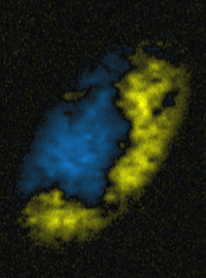HMC Physics Colloquium
Tuesdays at 16:30 in Shanahan Center for Teaching and Learning, Room B460
Colin V. Parker (’06)
James Franck Institute and Department of Physics, The University of Chicago
Feb. 10, 2015
For classical or quantum Hamiltonians, one typically writes the kinetic energy, or dispersion, as a simple parabola for small momentum. However, particles traveling in certain periodic potentials (i.e. lattices) may have a dispersion that is minimized at multiple values of momentum or that depends upon the fourth power of momentum, preventing such a simple description. My collaborators and I have realized these “engineered dispersions” experimentally by shaking cold cesium atoms back and forth in optical standing waves. Despite the fact that our atoms experience only short-range interactions, we observe behavior typically seen in strongly interacting condensed matter systems. For example, the atoms form domains like a ferromagnet (see image) despite having fixed spin. We also observe a set of excitations called rotons, first observed in superfluid helium, in which the phase and group velocity point in opposite directions. These experiments demonstrate the important role played by lattice-generated dispersion in many-body systems.



